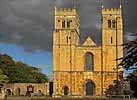 Worksop Worksop
Priory
Glass
Click the numbers in the key plan for details of the items.
The stained glass in the North aisle shows scenes from the Old Testament, and
that in the South aisle shows scenes from the New Testament. All is mid- to
late-19th century in date. Window 5 is by Capronnier, and other windows are
thought to be by Wailes and Hardman. The stained glass in the North and South
aisles was reset in the 1960s, with the main images floated in plain glass and
any subsidiary stained glass decoration removed, so as to admit more light into
the church. In this, the exercise was successful, but separating the main images
from any decoration they may have possessed, has unbalanced them and made their
colouring perhaps look cruder than was the artists' original intention.
South Transept
1. Window 1 comprises 20th century glass in a somewhat medieval style. It depicts Christ dressed in white, bearing a white flag which reads ‘Resurgam’, with souls rising around him, and a skeleton at his feet. There are decorative medallions above and below. Window 1 comprises 20th century glass in a somewhat medieval style. It depicts Christ dressed in white, bearing a white flag which reads ‘Resurgam’, with souls rising around him, and a skeleton at his feet. There are decorative medallions above and below.
South Aisle
2. Window 2 shows the parable of Christ the Good Shepherd (John 10:11-18). Portrayed in a restrained palette of red, blue and white, Jesus is shown with a crozier, carrying a lamb, with three ewes clustered at his feet. There is delicately depicted foliage and flowers in a range of greens and browns. Window 2 shows the parable of Christ the Good Shepherd (John 10:11-18). Portrayed in a restrained palette of red, blue and white, Jesus is shown with a crozier, carrying a lamb, with three ewes clustered at his feet. There is delicately depicted foliage and flowers in a range of greens and browns.
The inscription at the bottom of the window reads:
IN MEMORY OF
ALBERT VICKERMAN
BORN DEC: 1OTH 1839 DIED SEP: 27TH 1862 |
3. Window 3 illustrates the story of the woman who has been ill for many years, being cured by touching the hem of Christ’s garment; ‘Daughter be of good Comfort, thy Faith has made you Whole’ (Matthew 9:22, Luke 8:48). The figures are depicted in rich golds, reds, blues and white, with roses and oranges in the background. Window 3 illustrates the story of the woman who has been ill for many years, being cured by touching the hem of Christ’s garment; ‘Daughter be of good Comfort, thy Faith has made you Whole’ (Matthew 9:22, Luke 8:48). The figures are depicted in rich golds, reds, blues and white, with roses and oranges in the background.
The inscription reads:
IN MEMORY OF S HARRIET BOYD-KINNEAR
AND OF GEORGE FRITH SURGEON WORKSOP HER FATHER
THIS WINDOW IS PLACED BY HER HUSBAND |
4. Window 4 shows Christ saying to the Pharisees at the end of the Feast of the Tabernacles ‘I am the Light of the World’ (John 8: 12-20). Christ is depicted in white, glowing reds and blues, contrasting against the darkly dressed Pharisees and disciples. Window 4 shows Christ saying to the Pharisees at the end of the Feast of the Tabernacles ‘I am the Light of the World’ (John 8: 12-20). Christ is depicted in white, glowing reds and blues, contrasting against the darkly dressed Pharisees and disciples.
The inscription reads:
TO THE GLORY OF GOD AND IN PIOUS MEMORY OF
WILLIAM GREGORY LATE OF MANTON ORT JANY 8TH 1865 AET 90 |
5.
 |
 Inscription and Inscription and
maker's signature
|
Window 5 is signed in a small panel ‘J:B: CAPRONNIEM BRUXELLENSIS FECIT 1866’. John-Baptiste Capronnier (1814-1891) was a well-known artist who made windows in Belgium, the Netherlands, France, Italy and England, including three panels showing the Good Samaritan in St Peter’s Church, St Albans from 1867.
The panel depicts the parable of the Good Samaritan, who is shown tending the wounds of the traveller attacked by robbers (Luke 10 25-37). In the background stands the Samaritan’s donkey in front of a tree, and the shadowy forms of the priest and Levite who have passed by on the other side of the road. All is rendered in rich tones of burgundy and blue and the faces of the Samaritan, the injured traveller and the donkey are very sensitively delineated.
The inscription reads:
PLACED BY HIS CHILDREN IN AFFECTIONATE REMEMBRANCE OF SAMUEL WATKINS WHO DIED SEPT:XXVII M DCCC LXIV |
6. Window 6 is of brightly coloured nineteenth century glass, and shows Jesus, tired from travelling, asking the Samaritan woman to give him a drink of water from the well (John 4:4-42). Two disciples look on, remonstrating with Jesus. Window 6 is of brightly coloured nineteenth century glass, and shows Jesus, tired from travelling, asking the Samaritan woman to give him a drink of water from the well (John 4:4-42). Two disciples look on, remonstrating with Jesus.
The inscription reads poignantly:
TO THE MEMY OF SARAH ANN WATSON DAUGHTER OF ABRAHAM
MARY WATSON WHO DIED 7TH MARCH 1860 AGED 20 YEARS |
7.
Window 7 shows Christ healing a deaf man, with a disciple looking on (Mark 7:31-37).
The figures and foliage are depicted in rich colours with great detail.
The inscription reads:
IN MEMORY OF THOMAS BULLIVANT WHO DIED 11TH MAY 1825 AGED 71 & OF FRANCES HIS WIFE WHO DIED
17TH JAN:1854 AGED 84: THIS WINDOW IS ERECTED BY THEIR DAUGHTER |
8.
Window 8 was also erected by Anne Bullivant and is so similar in style to Window 7 that it is likely to have been by the same artist. Like Window 3, it may depict the story of the woman being cured by touching the hem of Christ’s garment, but it seems unlikely that there would be two such portrayals in the same church. It is more likely to show the Canaanite woman of great faith, beseeching Christ on behalf of her sick daughter (Matthew 15: 21-28). As in Window 7, Christ is accompanied by a saint, possibly John.
The inscription reads:
IN REMEMBRANCE OF JOHN CHAMPION WHO DIED 18TH OCT:1830: AGED 77: & OF MARTHA HIS WIFE WHO DIED
WINDOW IS ERECTED 19TH AVG:1860 AGED 78: THIS BY ANNE BULLIVANT NIECE OF THE ABOVE MARTHA CHAMPION 1866 |
9.
Window 9 shows Christ walking on water towards the disciples’ storm-tossed boat. Peter has tried to walk on the water towards Christ, but his faith has failed him, and he is struggling in the water. Christ saves him, with the words ‘Oh thou of little faith, wherefore didst thou doubt?’ (Matthew 14: 22-33). All is depicted very powerfully with the tumultuous sea and the terrified disciples contrasted with the serenity of Christ and the night sky above.
The inscription reads:
PRESENTED BY ELIZABETH SHAW IN LOVING MEMORY OF REUBEN SHAW
HER HUSBAND AND OF WILLIAM RICHARD SHAW HER SON A.D. 1875 |
A brass plaque beneath reads:

IN LOVING REMEMBRANCE OF THE ABOVE
NAMED WILLIAM RICHARD SHAW YOUNGEST
SON OF REUBEN SHAW WHO DIED MAY 24TH 1874
AGED 34 YEARS.
AND WAS INTERRED IN THIS CEMETERY.
THIS TABLET IS ERECTED BY HIS SORROWING WIFE. |
10. Window 10 shows Mary and the infant Christ above, and St Cuthbert below, in his bishop’s mitre, holding a crozier in his left hand. In his right hand he carries the head of the king and martyr St Oswald. Oswald’s head was discovered in the shrine of St Cuthbert when it was transferred to Durham in AD1104, hence they are often shown together. Both depictions have a background of bright red flowers in medallions. Window 10 shows Mary and the infant Christ above, and St Cuthbert below, in his bishop’s mitre, holding a crozier in his left hand. In his right hand he carries the head of the king and martyr St Oswald. Oswald’s head was discovered in the shrine of St Cuthbert when it was transferred to Durham in AD1104, hence they are often shown together. Both depictions have a background of bright red flowers in medallions.
The inscription reads:
TO THE GLORY OF GOD & TO THE MEMORY OF LOVISA BLANCHE THE BELOVED WIFE
OF CECIL GEORGE SAVILE FOLJAMBE OF COCKGLODE SHE DIED 7 OCTR 1871 ALSO
FREDERICK COMPTON SAVILE FOLJAMBE HER 2ND SON WHO DIED 21 AVGST 1871 |
A brass plaque beneath reads:

IN MEMORY OF LOUISA BLANCHE THE BELOVED WIFE OF CECIL GEORGE
SAVILE FOLJAMBE OF COCKGLODE, AND ELDEST DAUR OF FREDERICK JOHN
AND LADY FANNY HOWARD, SHE DIED 7 OCT. 1871 AGED 29, AND IS LAID
WITH HER 2ND SON IN THE VAULT AT SCOFTON ; THE ABOVE WINDOW IS
ERECTED BY HER SORROWING HUSBAND. |
Nave
11.
 |
 Detail showing Detail showing
St
Cuthbert holding
St Oswald's head |
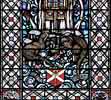 Detail showing Detail showing
two otters at
St Cuthbert's feet |
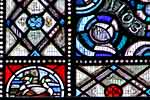 Detail showing an eider duck Detail showing an eider duck
and the artist's
signature ('HW 03') |
The fine west window is by Helen Whittaker, dating from 2003 and commemorating the 900th anniversary of the foundation of the Priory. It replaced a window of 1868, perhaps by O’Connor according to Pevsner. Predominantly in blue, with red and gold accents, the window depicts St Cuthbert carrying the head of St Oswald in his left hand, whilst giving the blessing with his right. At his feet are two otters, illustrating the endearing legend that, after St Cuthbert spent the night praying in the sea, he knelt on the beach to pray, and two otters came out of the water, warming his feet with their breath and drying him with their fur. Below the otters are the mitre, referring to his bishopric of Lindisfarne, and there are medallions of eider ducks, also known as ‘cuddy’ ducks from the name of St Cuthbert, and other seabirds, referring to his life as a hermit on Farne Island.
North Aisle
12.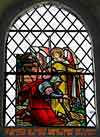 Window 12 depicts in fine detail Joshua at the walls of Jericho. He is dressed in mail, wearing a red cloak and carrying a spear. He is kneeling before the Captain of the Lord’s Host, wingèd and bearing a sword. Palm trees and the walls of Jericho are visible behind them (Joshua 5 13-15). Window 12 depicts in fine detail Joshua at the walls of Jericho. He is dressed in mail, wearing a red cloak and carrying a spear. He is kneeling before the Captain of the Lord’s Host, wingèd and bearing a sword. Palm trees and the walls of Jericho are visible behind them (Joshua 5 13-15).
The inscription reads:
In memory of Robert Butlin Smith late Captain
of the LXXIII Regt who died Nov 1st 1880 aged 60 years |
13. 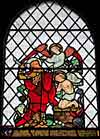 Window 13 depicts the story of Abraham and Isaac, from Genesis 22. Abraham is shown at the point where he has placed Isaac on the altar, blindfolded, and is preparing to sacrifice him, a knife held in his right hand, the fire ready by the altar. The Angel of the Lord appears, and says ‘lay not thine hand upon the lad, neither do thou any thing unto him: for now I know that thou fearest God, seeing thou hast not withheld thy son, thine only son from me’. Looking round, Abraham sees a ram caught in a thicket, to offer as a sacrifice instead. Window 13 depicts the story of Abraham and Isaac, from Genesis 22. Abraham is shown at the point where he has placed Isaac on the altar, blindfolded, and is preparing to sacrifice him, a knife held in his right hand, the fire ready by the altar. The Angel of the Lord appears, and says ‘lay not thine hand upon the lad, neither do thou any thing unto him: for now I know that thou fearest God, seeing thou hast not withheld thy son, thine only son from me’. Looking round, Abraham sees a ram caught in a thicket, to offer as a sacrifice instead.
The beautiful lettering reads:
THIS WINDOW WAS ERECTED BY JOSEPH MAYOR JUNIOR IN AFFECTIONATE
REMEMBRANCE OF SARAH HIS BELOVED WIFE (NATIVE OF PEEL (ISLE OF MAN) WHO
DEPARTED THIS LIFE JULY I 1863 AGED 34 YEARS & WAS INTERRED NEAR THIS SPOT. |
There is a small medallion showing the arms of the Isle of Man, symbolising where Mrs Mayor was born.
14.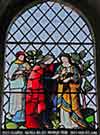 Window 14 is similar in style to Window 13, and may have been by the same artist. It shows Naomi with her daughters-in-law Orpah and Ruth, as they prepare to leave the land of Moab for Judah. Naomi tries to dissuade them from accompanying her, and Orpah turns back. Ruth, shown in red embracing Naomi, says to her ‘Thy people shall be my people and thy God my God’ and carries on, ultimately remarrying and founding the line of King David (Ruth 1:16-17). Window 14 is similar in style to Window 13, and may have been by the same artist. It shows Naomi with her daughters-in-law Orpah and Ruth, as they prepare to leave the land of Moab for Judah. Naomi tries to dissuade them from accompanying her, and Orpah turns back. Ruth, shown in red embracing Naomi, says to her ‘Thy people shall be my people and thy God my God’ and carries on, ultimately remarrying and founding the line of King David (Ruth 1:16-17).
The inscription at the bottom of the window reads:
TO THE GLORY OF GOD AND IN MEMORY OF
MARY HERMON OWTRAM WHO DIED 26TH APRIL A.D. 1866 |
15. Window 15 depicts the incident during the journey to the Promised Land when Moses strikes the rock to obtain water. ‘And Moses lifted up his hand, and with his rod he struck the rock twice, and the water came out abundantly, and the congregation drank, and their beasts also’ (Numbers 20:11). Window 15 depicts the incident during the journey to the Promised Land when Moses strikes the rock to obtain water. ‘And Moses lifted up his hand, and with his rod he struck the rock twice, and the water came out abundantly, and the congregation drank, and their beasts also’ (Numbers 20:11).
The window has the dedication:
+ IN MEMORY OF EDWARD BAXTER
WHO DIED OCTOBER X MDCCCXLVII |
16.
Window 16 is similar in style to Window 15 and may have been by the same artist. It depicts another Old Testament image; Moses bringing the tablets on which are inscribed the Ten Commandments down from Mount Sinai (Exodus 32:15).
The inscription states:
TO THE GLORY OF GOD & IN MEMY OF WM GRAFTON WHO DIED JAN 2 1847
AGED 83 YRS THIS WINDOW IS DEDICED BY HIS NIECE MARY ANNE DAWSON |
17. Window 17 depicts King David playing his harp, surrounded by a boys’ choir with hymnals. David’s robe and cloak are depicted in rich detail, as are the boys’ tunics. Two trees, bearing fruit and flowers, are visible behind David’s seat. The window is dedicated Window 17 depicts King David playing his harp, surrounded by a boys’ choir with hymnals. David’s robe and cloak are depicted in rich detail, as are the boys’ tunics. Two trees, bearing fruit and flowers, are visible behind David’s seat. The window is dedicated
+ TO THE MEMORY OF JAMES SCOTT OF WORKSOP
WHO DIED 12 DECEMBER 1865 AGED 80 YEARS |
18. Window 18 may be a depiction of Jacob blessing the sons of Joseph (Genesis 48). The glass is rather poorly preserved. Window 18 may be a depiction of Jacob blessing the sons of Joseph (Genesis 48). The glass is rather poorly preserved.
The inscription, though damaged, reads:
ROBERT JOHN GAINSFORD DIED 6 FEBRUARY A.D. 1870 AET 63 |
North Transept
Chancel
21.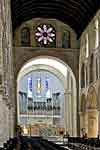 Window 21 is a small rose window retained from Nicholson’s 1845-9
restoration. It comprises decorative segments and a series of depictions
of builders’ and masons’ tools, including set squares, a trowel
and hammer, dividers and a set square, a saw and axe, a crow-bar, pincers
and a mallet.
Window 21 is a small rose window retained from Nicholson’s 1845-9
restoration. It comprises decorative segments and a series of depictions
of builders’ and masons’ tools, including set squares, a trowel
and hammer, dividers and a set square, a saw and axe, a crow-bar, pincers
and a mallet.
Lady Chapel
22.
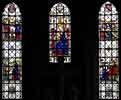 |
 The Annuciation The Annuciation |
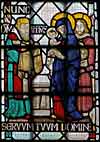 Scene in Scene in
the Temple |
 Madonna Madonna
and Child |
 Three Marys Three Marys |
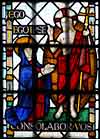 Mary at the Mary at the
Ascension of Christ |
There is stained glass in the three eastern lancet windows in the Lady Chapel. It is signed Douglas Purnell 1953, although it is thought to incorporate earlier as well as contemporary work (Hartwell et al 2020). It was given by Mrs d’Arcy in memory of her husband, vicar from 1909 to 1941. A brass plaque below the window reads:
The glass in the east windows in this chapel
was given in memory of
GEORGE JAMES AUDOMAR D’ARCY
Hon Canon of Southwell
Vicar of Worksop 1909 – 1941
by his widow Amy Louisa d’Arcy 1951 |
The medallion was given by Mrs K T Blatherwick, and comprises a medallion of St Cuthbert, with an inscription reading ‘Gratia Dei’.
The central and principal window shows the Madonna and Child, enthroned in majesty under an elaborate canopy, with the dove of the Holy Spirit above. Mary is dressed in red and blue, symbolising the blood of life and the sky and Heaven respectively, that is, the link between the human and the Divine.
At the top of the left-hand window is the Annunciation. The Angel Gabriel is depicted in a blue robe with a purple cloak, holding a golden staff. Mary is shown again in a red gown and a blue mantle, and between them is a vase of lilies, symbolising purity. Above, a dove hovers, indicating the Holy Spirit. The inscription reads ‘Ave, gratia plena, Dominus tecum’ – (Hail, full of grace, the Lord is with you). Below is the scene in the Temple 40 days after the birth of Jesus, where Simeon recognises Him as Christ, takes Him in his arms, and declares ‘Nunc Dimittis Servum Tuum Domine’ – (Lord, now lettest thou thy servant depart in peace (Luke 2:25-35)). Mary is again in red and blue, Joseph in pink and Simeon dressed as a priest of the Temple in turquoise. At the top of the window is a panel with a coat of arms, possibly Lascelles, and at the bottom, the medallion of St Cuthbert noted above.
In Luke 2:35 Simeon prophecies the sorrows of Mary ‘Yea, a sword shall pierce through thine own soul also’ and at the top of the right hand window is a depiction of the three Marys at the Descent from the Cross, Mary Mother of God with Mary Magdalene and Mary the wife of Cleophas, the brother of Joseph (John 19:25). The inscription is from Lamentations 1:12 and reads ‘Videte si est dolor sicut dolor meus’ (See if there be any sorrow like unto my sorrow). Mary Magdalene is shown traditionally with long hair carrying ointment, and Mary of Cleophas is in pink. Above the depiction are the arms of Furnival. Below is a small piece of glass with the letters I, an abbreviation of the name of Jesus in Greek (IHΣOYΣ).
The lower image in the right hand window shows Mary present at the Ascension of Christ. In a parallel with the window showing Simeon at the Temple, the Ascension took place 40 days after the Resurrection. Christ is shown in red, surrounded by a golden aureola or mandorla, his right hand raised in blessing, his left holding a cross. Mary is in red and blue, kneeling. The inscription reads ‘Ego ego ipse consolabor vos’ (I even I am He that comforteth you) (Isaiah 51:12). Below is an heraldic shield surmounted by a bull, with the motto ‘Un dieu un Roy’ (One God one King).
|